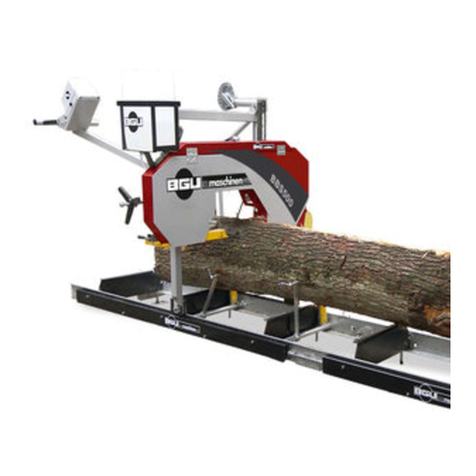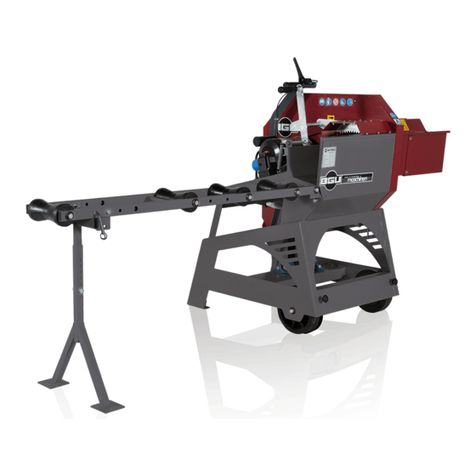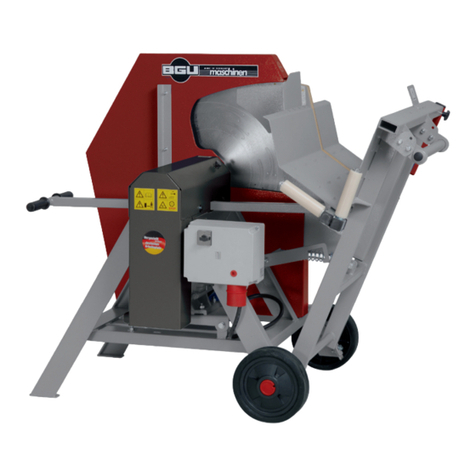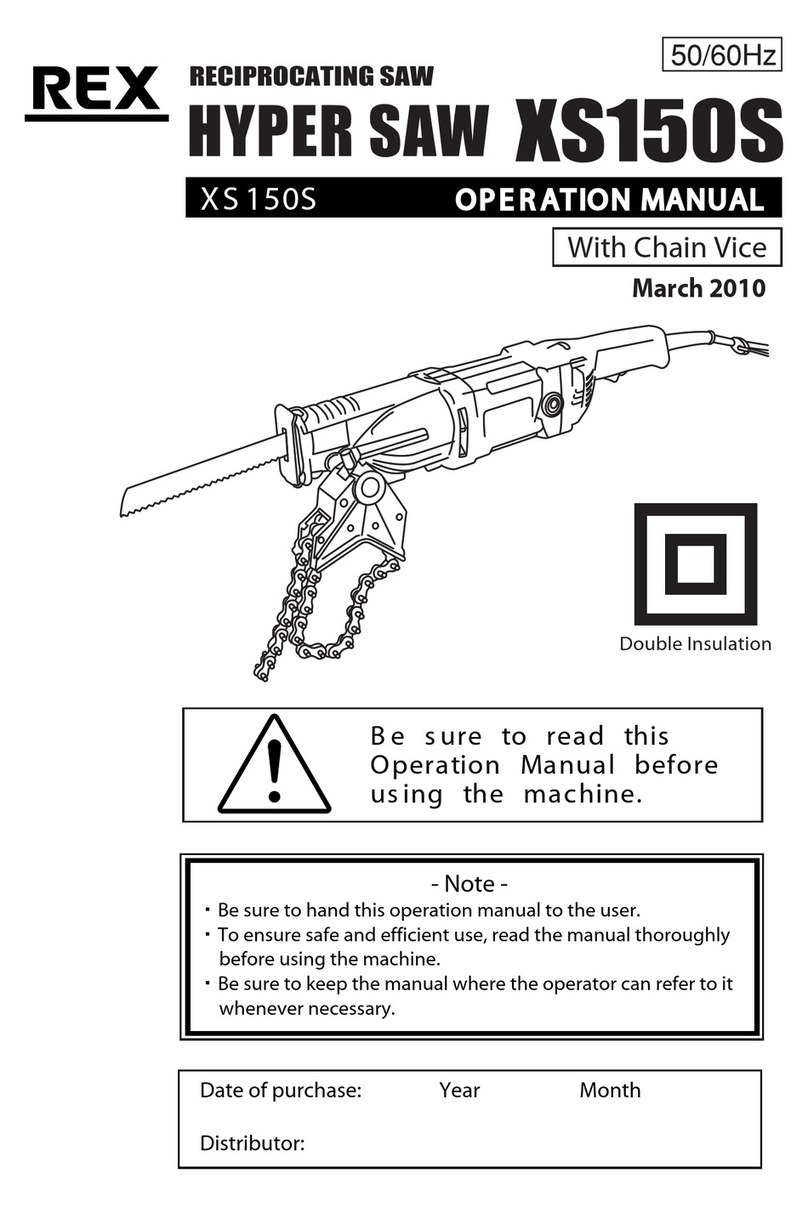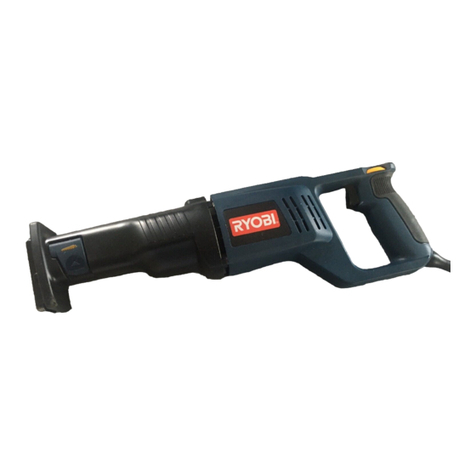BGU WK 780 RB/2 User manual

Südharzer Maschinenbau GmbH
Helmestraße 94 ∙ 99734 Nordhausen/Harz
Zentrale: 03631/6297-0 ∙ 7-111
Internet: www.bgu-maschinen.de
e-mail: [email protected]
USER‘S MANUAL
Carefully read these instructions
before starting and using your saw!
LOG CUTTING SAW
WK 780 RB / 2
We manufacture
in Germany
Set-up & installation
Use
Maintenance
Accessories

2
CONTENT
List of Contents 2
1. General information 3
1.1 About this manual 3
1.2 Delivery and transport claims 3
2. Product overview 5
2.1 Logs cutting saw with log carriage and electric motor 5
3. Safety pictograms and warning labels 6
4. Safety instructions 8
4.1 Safety rules about saw blade 9
4.2 Mandatory application field and compliant use 10
5. Operating instructions 11
6. Repairs and maintenance 12
6.1 Regular maintenance 12
6.2 Cleaning at the end of work 12
6.3 Tensioning and replacing the V-belt 13
6.4 Lubricating the blade shaft bearings 13
6.5 Replacing the saw blade 13
6.6 Consumables 13
7. Accessories 14
8. Handling and transportation 15
9. Dismounting and disposing of an obsolete machine 15
10. Technical data 16
9.1 Noise emissions 16
11. Trouble-shooting 18
12. Other areas of possible hazard 18
11.1 Mechanical dangers 18
11.2 Environmental dangers 18
13. Warranty 19
14. Spare parts list WK 780 R/B 20
15. EC Statement of compliance 23
Annex Instruction manual for GX270 Honda engine

3
Dear customer,
thank you very much for your trust and preference in choosing our
equipment and joining the number of our best customers in the world.
We are confident that our equipment will be up to all your expectati-
ons and assure you a long lasting quality and performance.
1.1 About this manual
Please take time to read this manual and learn to how operate and
maintain the saw safely.
For your easier reading this manual is laid out in several sections.
The sections are progressively numbered 1 through 15 and listed on
the “content” page.
The information, pictures and technical data in this document reflect
current or planned product features, functions, and characteristics as
of the publication date. Because of on-going product improvements
and feature additions, information in this document is subject to
change without notice.
If you are experiencing a problem or functional trouble on your machine,
please read the “trouble-shooting” section to identify possible causes and
remedies. When you have checked all the possible causes listed and you are
still experiencing the problem, ask your Authorized Service Centre for help.
When you order parts maintenance or repair services, your Authorized
Service Centre, your dealer or eventually the manufacturer need your
machine serial number and engine serial number. These are the num-
bers that you have recorded on the product identification label of the
manufacturer on the machine.
1.2 Delivery and transport claims
Upon delivery of the machine please check for visual machine dama-
ges such as damaged packing or scratched buckled parts. If so, make
a remark on all copies of the delivery bill (including the one for you)
before signing for acceptance and let the driver sign all copies.
Should your shipper or the truck driver refuse to accept your claim,
fully reject delivery and make sure to inform us (the manufacturer)
immediately. No claims shall be taken into account by the shipper or
by the insurance company, if a reservation note is not made on the
delivery bill.
1. GENERAL INFORMATION

4
All transport damages must be notified within latest 2 days from de-
livery. Therefore delivery must be collected and inspected within this
term. Later claims shall be disregarded.
In case of assumed but not visually clear transport damages make
sure to mark the following sentence on the delivery bill : „Reserved
delivery due to assumed transportation damages“.
Insurance and shipping companies act with extreme caution in case of
transport damages and sometimes refuse to accept responsibility.
Please make sure to provide clear and exhaustive evidence (photos)
of the claimed damages.
Thank you in advance for your help and understanding in this matter.
Haben Sie für Vorstehendes Verständnis.

5
Upper hood
Wheels
Log carriage
Saw blade
2. PRODUCT OVERVIEW
2.1 Logs cutting saw with electric motor
Engine
Grip handle
Steel stand

6
1 . Machine safety label
„Before setting-up, servicing, maintaining and clea-
ning the machine, disengage power and stop the
engine. Lock the tool and secure it against acciden-
tal start.“
This safety label reminds users of a pinched hands dan-
ger.
2. Safety pictogram „Direction arrow“
Motor, PTO shaft and driveline must be turning in the sa-
me direction as shown by this arrow.
3. Safety-alert symbol
Read and recognize safety information. Be alert to the po-
tential for personal injury when you see this safety alert
symbol.
4. Identification label „Product Identification“
This label shows the company details of the manufacturer
and the main machine technical data.
6. “BGU-maschinen” Manufacturer’s logo
7. Personal protection sign
„Mind these instructions“!
3. WARN- UND SICHERHEITSAUFKLEBER

7
Vorsicht !
Heiße Teile
8. Personal protection sign
„BEFORE OPERATING READ OPERATOR’S
MANUAL AND SAFETY INSTRUCTIONS!“
To avoid personal injury or death, carefully read and un-
derstand all instructions pertaining to the saw including
the engine manufacturer’s operating and maintenance in-
struction manual.
9. Safety pictogram
“Wear suitable protective boots!”
10. Safety pictogram
“Wear suitable protective gloves!”
11.Warning pictogram
Do not operate the machine indoors!
12.Safety pictogram
Loud noise can cause impairment or loss of hearing, wear
a suitable protective device such as ear plugs and safety
goggles!
13. Machine safety label
Keep your hands off all machine parts identifi ed by this
label! Burning danger.

8
Strictly perform installation, set-up, maintenance, cleaning
and transportation with the motor switched off and the blade
firmly secured against accidental operation.
Immediately disconnect power off the machine in case of any
eventual fault or trouble.
The user shall strictly comply with these operation, set-up, mainte-
nance, repair and trouble-shooting instructions in order to assure safe
operation and no damages to the equipment. Moreover we recom-
mend to let the machine be run only and strictly by trained and skilled
staff who must be familiar with the applicable occupational safety and
health administration rules as well as applicable transportation rules.
Incorrect use of the saw can cause serious injury or death.
No person under school leaving age should operate a circular saw.
Those who have reached school leaving age but are below the age of
18 may operate a circular saw if supervised by a competent person of
18 years or over. The machine shall be installed and kept in a suitable
location selected by the customer for safest operation. Make sure that
the equipment stands on a safe stable foundation.
The working area around the machine must be kept as clear as pos-
sible from surrounding obstacles and slippery foundation floors should
be duly treated (do not use saw dust or wood ash for this purpose).
Do not allow within the hazardous zone any unauthorized third or per-
sons who are not familiar with the dangers related to use and opera-
tion of the machine. Allow no bystanders, especially children and pets
in the working area.
● Due and proper illumination of the working site must be provided at
all times.
● The saw blade must be duly sharpened for maximum performance
and no recoil danger. Flash and chips must be removed off the
crown wheel.
● Damaged or buckled blades (very likely to break during operation)
should not be used.
● Always wear suitable hearing (ear plugs or muffs) and eye
protection (goggles or safety glasses) while operating the machine.
● Ensure that a wide but confined area is available around the machine
and assure maximum working freedom.
4. SAFETY INSTRUCTIONS

9
● Operators must wear steel toe safety shoes and snug-fitting and
tear-resistant work cloths
● No additional customised protections or tools should be provided on
board of the machine, other than the ones designed and supplied by
the manufacturer.
● Do not apply pressure (for instance by means of the wood stock)
against the blade to make it come to a quicker stop.
● The machine is not designed for indoor use (dust release).
● NEVER leave the machine unattended with the running motor.
● Before leaving the operator‘s station for any reason, stop the machine motor,
disconnect power and secure the machine against accidental operation.
● Logging and woodworking involve a lot of operator’s care and attention.
Make sure to feel perfectly fit and comfortable when you work with a
saw. Stop and take a rest at first occurrence of any stressful
condition or sign of fatigue.
4.1 Safety rules about saw blade
The unit is strictly designed for use with a 700mm (outer diameter)
blade.
The blade (Cr) is capable to withstand a maximum number of revolu-
tions of 3000 rev. per minute.
Strictly use blades as per EN Standard 847-1.
Do not ever use worn out blades in need of sharpening.
Make sure that the blade shows good conditions, no damages, no
cracks, no buckling and no missing/broken teeth/bits.
Hard metal blades require special care and handling. Make sure that
the blade bits do not ever hit against hard surfaces (for example con-
crete floors), which might cause invisible bits damage. Hard metal
blades must be suitable to operate at 2700 revolutions per minute

10
4.2 Mandatory application field and compliant use
These log-cutting saws are strictly designed for preparation of fire-
wood. Sawing to be strictly performed with wood stock on the log
trough. All other applications are forbidden and considered as “misu-
se”. The manufacturer is not liable for any damage or injury resulting
from misuse!
The machine is capable to handle wood stocks in diameter of 8-26 cm.
Shrubs and tiny branches bundles must be loaded on the trough and
securely hold on both sides of the blade.
The machine is strictly conceived for ONE-MAN OPERATION ONLY.

11
5. OPERATING INSTRUCTIONS
This log-cutting saw model WK 780 RB / 2 is ideally recommended
for stationary use in your yard.
A rugged all-steel construction assures longest machine life at any
operative condition.
This machine is specially designed to work with a 700 mm blade ap-
proved and manufactured to EN 847-1.
This machine is equipped with inbuilt gasoline engine for independent
power provision. Please read the instructions of the engine manufac-
turer before use
.
For safer filling of the engine, the machine is supplied with a fuel fil-
ling funnel. Please fill with care and avoid fuel spillage and overflo-
wing. While filling, make sure to avoid inhaling petrol vapours.
If you working with twisted or crooked logs make sure to load the
log on the carriage, so that the bolged side of the log is turned to the
blade in order to avoid the log from tipping over or jamming during
cutting and consequent possible even major damages to the blade.
Now fasten the grip on the log carriage and push to smoothly tilt it
over towards and through the blade.
NOTE: avoid excessive pressure on the carriage through the
blade with cutting. Excessive hold-down pressure may slow
the blade down and cause dangerous jamming!
When pushing the log through the blade avoid all jerky, bumpy mo-
vements that could lead to risky and dangerous situations. Timber
in maximum length of 1.1 m must lay on the carriage by the entire
length with no projecting end. After the first log is cut off the timber,
let the carraige swing down to start-position (wide opened) before ad-
vancing the remaining timber to the blade and starting a new sawing
cycle. If you try to feed the stock forward and cut before the carria-
ge reaches back to start position, you may run the risk of hitting the
stock against the blade guard consequently causing severe personal
injuries and machine damages for which the manufacturer carries no
liability.
If the maximum 16 mm spacing between clearance inserts
(wood strips) is reduced because of excessive wear, provide
for immediate replacement of the wooden inserts.
(see Figure 2)
Fig. 2
„Max clearance between inserts“
Fig. 1
„Filling funnel

12
Make sure that the machine is fully disconnected and all mo-
ving parts are secured before performing any maintenance/re-
pair work on the machine. In the event of any malfunctioning,
switch the machine off before trouble-shooting.
6.1 Ordinary maintenance
The following tasks belong to ordinary maintenance works:
● Clean the machine from eventual residual wood, chips or dirt.
● Lubricate all moving parts.
● Grease all pivoting parts of the log carriage.
● Check-up and eventually stretch the V-belts, if required.
● Lubricate the bearings beneath the blade arbour.
● Check the oil-level in the engine
6.2 Cleaning after use
Remove wood chips and saw dust produced and left on the machine
during work.Clean the log carriage assembly removing all wood rests.
6.3 Tensioning and replacing the V-belt
If you are operating a WK 780 RB /2 model, proper maintenance re-
quires re-tensioning of the belt after a certain number of operation
hours. To perform stretching of the V-belt, you need adjusting the
special regulation screw located underneath the gearbox cover.
Release the engine mount fixation and adjust the V-belt so that you
can still provoke an approx. 10 mm of deflection by applying one fin-
ger tip pressure (see figure 3 - Stretching of the V-belt).
Fit the gearbox cover and the engine mount back into place before
operating the machine again.
Running the saw with a loose V-belt will cause increased wear and
shorten you belt life.
6. REPAIRS AND MAINTENANCE
Figure 3 - Stretching of the V-belt
Sheaves centre distance
Approx. 10 mm deflection load

13
To replace the belt, release the clamp-screws and remove the
safety guard from the V-belt drive area. Remove the old belts from the
sheaves and fit the new ones on. Make sure to refit the V-belt casing
back in place before operating the machine again.
BEWARE: failure to provide due re-tensioning will result into a less ef-
ficient V-belt drive that slips and may be wear out faster
6.4 Lubricating the blade shaft bearings
If you are using a „WK 780 RB / 2“ model, make sure to provide pe-
riodical lubrication of the blade shaft after each 100 hours of operati-
on. Remove both cover plates on the safety guard over the blade shaft
and use a regular greasing gun to perform bearings lubrication. Make
sure to refit both cover plates before working again
.
6.5 Replacing the saw blade
To replace the blade, following precautions must be taken at all times:
● Disconnect power off the machine (unplug power cord or stop the motor of
the tractor) and wait for the blade to come to a complete stop.
● Tipp the upper blade hood over by releasing the 4 hex-nuts.
● Release and undo the fixation bolt on the blade clamping flange
using a spanner and hold the blade using another spanner to
secure the blade flange on the motor side as you undo the nut.
(this to prevent the blade from turning as you undo the bolt.)
● Remove the clamping flange.
● Pull the old blade off the shaft (make sure to wear tear-resistant
gloves. DANGER!)
● Fit the new blade on the shaft. Note direction of rotation. All tools
must always work against the feed direction that is revolutions must
occur towards the operator’s station.
● Mount the locking flange back on the blade shaft minding the right
position of the feather-key in the flange.
● Tighten fixation bolt on the flange. BEWARE: when assembling the
new blade make sure to follow the dismounting procedure: saw blade,
external saw blade clamping flange, washer, fixation screw.
● Refit the blade hood in the original position duly set and clamped.
6.6 Consumables
The machine is equipped with the following consumable parts for
which no warranty is given!
Circular saw blade (Part no. 95011 CR) ,(Part no. 95021 HM)
Wood strips (left:Part no. 56373, right:Part no. 56372 and 56374)
V-belt (Part no.54183)
Fig. 4
„Direction of blade
Periodically check the performance of your saw. If cutting is
no longer clean and efficient let a specialist service regrind the
blade. Do not self-sharpen!
log
carriage
Saw blade

14
7. ACCESSORIES
On request the machine may be equipped with a special jaw for effi-
cient and safe clamping of the log after cutting.
Code Nr.:91273
*Zubehörteile sind keine Grundausstattung und somit zusätzliche Kosten.
FIg. 5
„Clamping jaw

15
Log & timber cutting saws are light equipment that can be easily mo-
ved on short-distance by means of two caster wheels and an ergono-
mic, comfortable grip handle located on the chassis on the opposite
side as the log carriage.
In order to avoid infringement of the clearance area around the ma-
chine, the grip handle is retractable (push/pull) on the model WK 780
R/B - 2.
Simply fasten the grip and lift the saw for safe and rapid hauling of
the machine.
For safety reasons the grip handle should remain retracted (or lifted-
up) during work to avoid risk of tripping or entanglement
8. HANDLING AND TRANSPORTATION
When the machine is fully obsolete and cannot be of any longer use, it should be
duly dismounted ahead of discarding. Certain components need deactivation and
dismantling in order to assure that no further use is made by other parties and
that no worn out parts are recycled for other applications.
During dismantle be alert for possible recyclable materials and components that
belong to differentiated waste collection procedures applicable in your country.
The manufacturer is not liable and undertakes no responsibility for per-
sonal injuries or damages that may result from the recycling of worn out
machine parts and eventual re-use in other applications different than ori-
ginally stated in this manual.
Dismantling procedure: each and every dismantling task must be per-
formed by authorized service centres or trained skilled staff only!
● Pull the machine down into single components
● Lock and clamp all moving machine parts
● Deliver each single component only to authorized waste management
facilities
● Remove rubber and plastic parts from the machine that must be
separately disposed
Deactivated, clamped moving/driving parts and components are of no
further risk and danger.
Electric components must be separately disposed to avoid substantial en-
vironmental threat. In the event of fire on the electric deployment system
of the machine, use of an explosion-proof extinguish system is required
(for example powder fire extinguishers).
9.
DISMOUNTING AND DISPOSING OF AN OBSOLETE
MACHINE

16
10.1 Noise emissions
The noise level was measured in compliance with the general rules for
establishment of noise and acoustic pollution of garden and agricultu-
ral equipment on work sites as well as with other national standards
for noise measurement. The applicable measuring parameters were:
Measurement on the machine front edge at 1600 mm height and
400mm away from the blade on the right hand side, while processing
beech wood in the size of 80+/-5% of the admissible timber diameter
as per this instruction
Leerlauf 90 db(A)
Volllast 95 db(A)
Use of ears protectors is mandatory!
be therefore assumed as for a safe work environment. Although there
is a relationship between noise emission and immission levels, this is
Technical data Einheit WK 780 RB / 2
max. max. timber diameter mm 240
Saw blade diameter mm 700/30
Motor power P1 S6 40% ED kW 6,6
Displacement cm3 270
Speed l 6
Starter U/min 1450
Machine size with opened
log carriage
Reversierstarter
Length
Width mm 1220
Hight mm 865
Weight mm 1100
Gewicht kg ca. 130
10. TECHNICAL SPECIFICATIONS

17
not a sufficient basis to determine the extent of on-site required pro-
tection. There are a lot of other factors that can influence site work
and risk of injuries and namely: the actual site/buildings configura-
tion, the concomitant presence of other noise sources (for instance
other machines performing other works in the neighbourhood) etc...
The factors applied for determining safety of a workplace may also ve-
ry from one country to the other. We are reporting here the noise va-
lues detected in the facility of the manufacturer on order to allow the
user performing a better evaluation of the possible risk/disturbance
involved with this machine and the related protection measures.

18
11. TROUBLESHOOTING
The following section will detail procedures for checking your
saw, should you encounter a malfunction.
Important! Before setting, operating, cleaning, maintaining or
repairing the processor, read the manufacturer’s operating and
maintenance instruction manual.
Trouble description
Possible causes Remedies
The saw doesn‘t start - Faulty engine
- Fuel is missing
- insufficient motor oil
- Fix/change the engine
- Fill fuel
- Touch oil up
The saw starts but the
blade doesn‘t operate
- Locking flange of the blade
shaft is not tight
- Loose V-belt
- Tighten the bolt
- Tension the V-belt
Blade chops - Stump blade - Sharpen or replace the blade
12. OTHER AREAS OF POSSIBLE DANGER
12.1 Mechanical dangers
Possible dangers related to machine moving parts (for example chain-
saw and v-belts) are minimized by means of suitable safeties and
protections that cannot be dismounted unless special tools and equip-
ment are used.
DANGER: removing or by-passing inbuilt machine safeties may result
into serious operator’s personal injuries
11.2 Environmental dangers
The machine is strictly designed for outdoor applications.
DANGER: do not operate the machine indoors to avoid risk of inhaling
wood dust.

19
13. WARRANTY
All BGU machines are covered with warranty terms in accordance with
the law. Customers should promptly notify the manufacturer eventual
material or production claims on their detection. While asking for war-
ranty service, customer should show copy of their purchase invoice or
receipt. The warranty does not cover for faults due to natural wear,
temperature or weather agents as well as misuse, faulty installation
or set-up, improper operation and lubrication or acts of vandalism.
No warranty will be given on parts damaged by improper handling,
use and application. The manufacturer is further not responsible for
warranty service on machines used for other applications than men-
tioned in this manual, altered or modified by the customer or other
thirds, or overloaded. Never attempt to use an incomplete machine or
one fitted with unauthorized modification. Any modifications to your
machine can cause personal injuries, and will void your warranty.
Consumable parts with a prescribed life (i.e. pulleys, tools and various
auxiliary materials) are excluded from the warranty as well as adjust-
ment, optimization and fine-setting or retrofitting works.

20
14. ERSATZTEILLISTE WK 780 RB
WK 780 R/B
Stand Juni 2009
12
29,51,8
1
2
3
4
5
6
7
9
10
11
23
14
22
16
17,18
28
20
32
55
36
2x43
56
37,50,47,23
37,50
47,23
30
48
13
37,41,
47,53
27
2x41
53
26,41,53
28
2x47
53
56,43,49,36
35
3x43
56
34
2x42
2x58
2x42
58
65
66
67 53
62
59
60
61,31,54,57
3x44
15
19
33
2x42 64
55
68,2x45
33,42 63
55,58
42
40
42
55
69,70
24
25
27
2x41
53
Table of contents
Other BGU Saw manuals
Popular Saw manuals by other brands
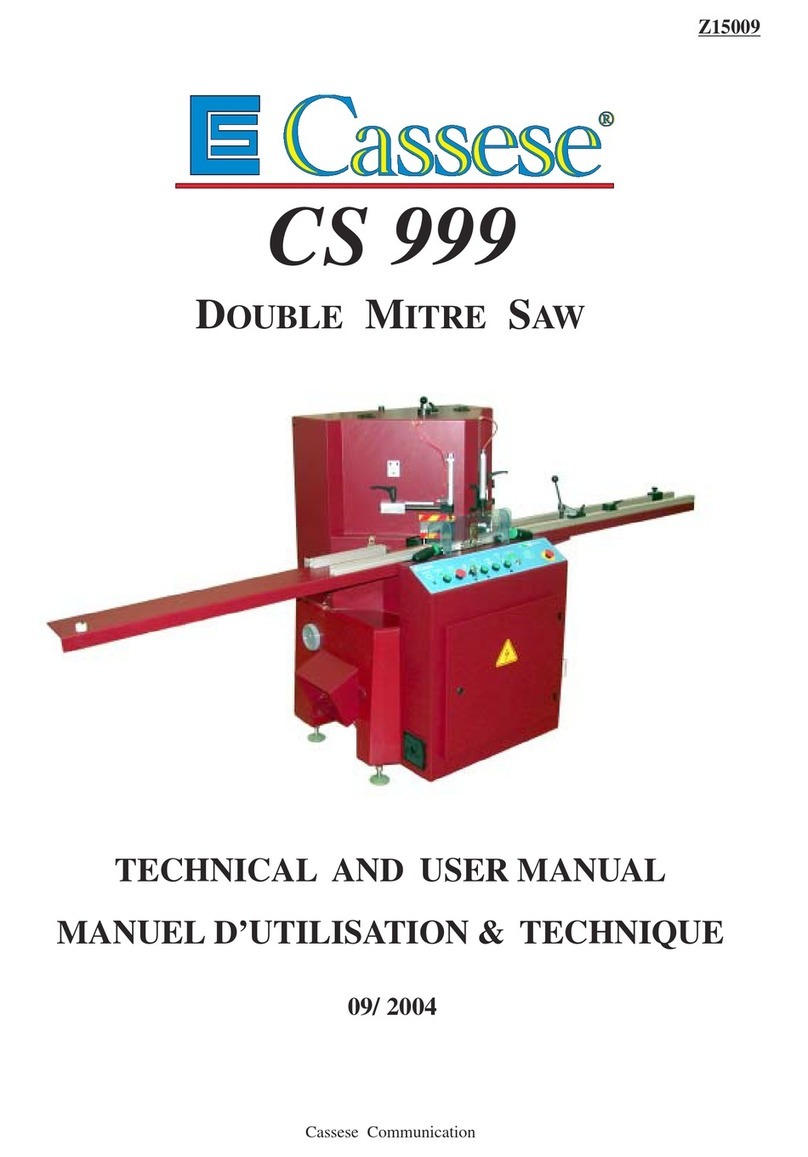
Cassese
Cassese CS 999 TECHNICAL AND USER MANUAL

Engine
Engine G15 Safety, Operation, Maintenance & Parts Manual
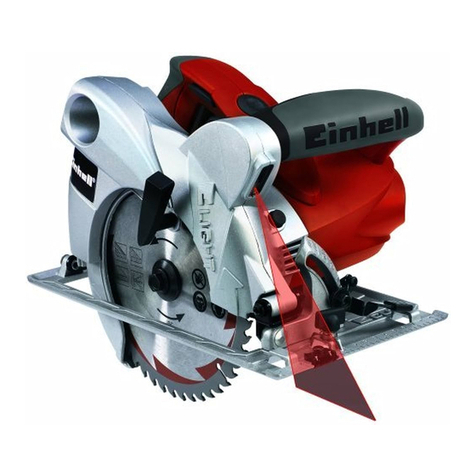
EINHELL
EINHELL RT-CS 190 L Original operating instructions
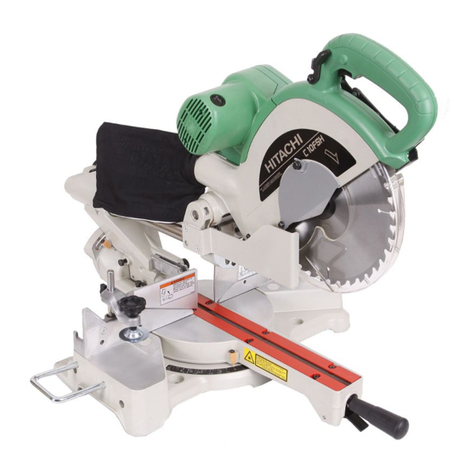
Hitachi
Hitachi C 10FSHCT Safety instructions and instruction manual
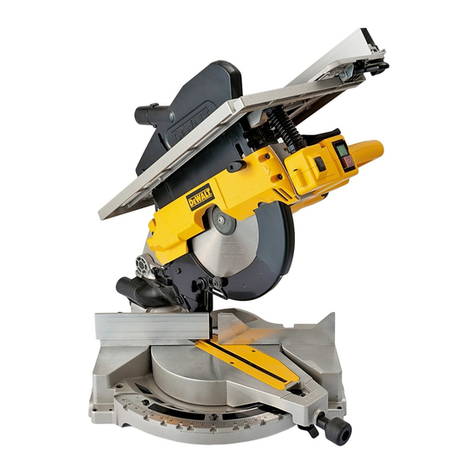
DeWalt
DeWalt D27113-LX Original instructions
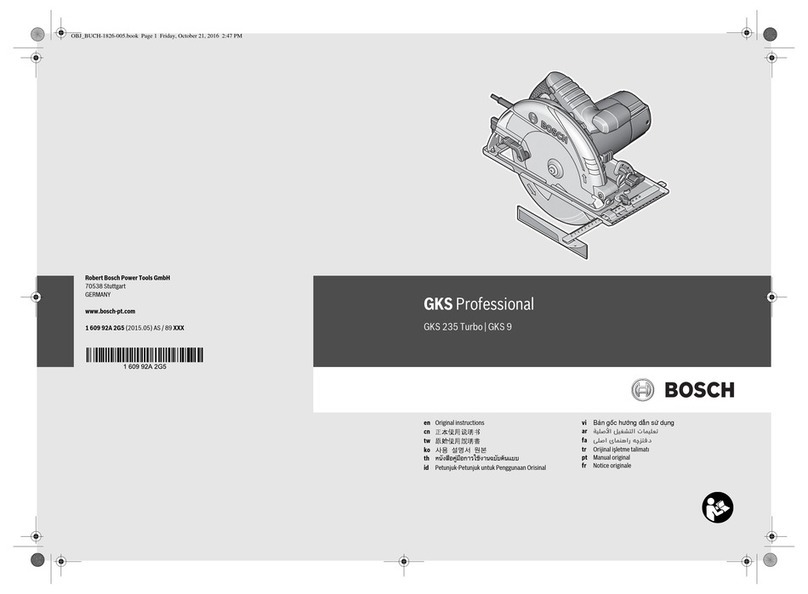
Bosch
Bosch GKS 235 Turbo Professional instructions
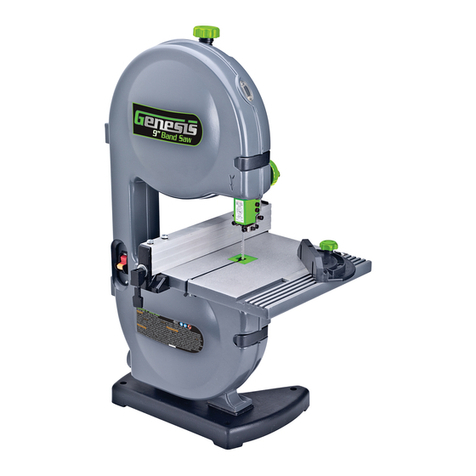
Genesis
Genesis GBS900 Operator's manual

Makita
Makita LS002G instruction manual
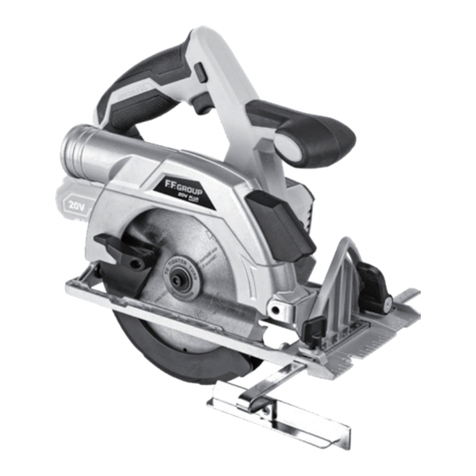
F.F. Group
F.F. Group CCS 165-BL 20V PLUS Original instructions
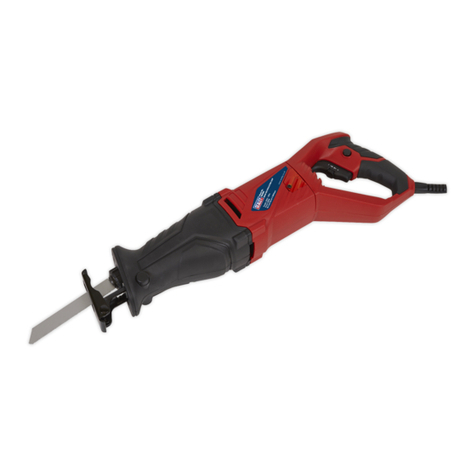
Sealey
Sealey SRS850 manual
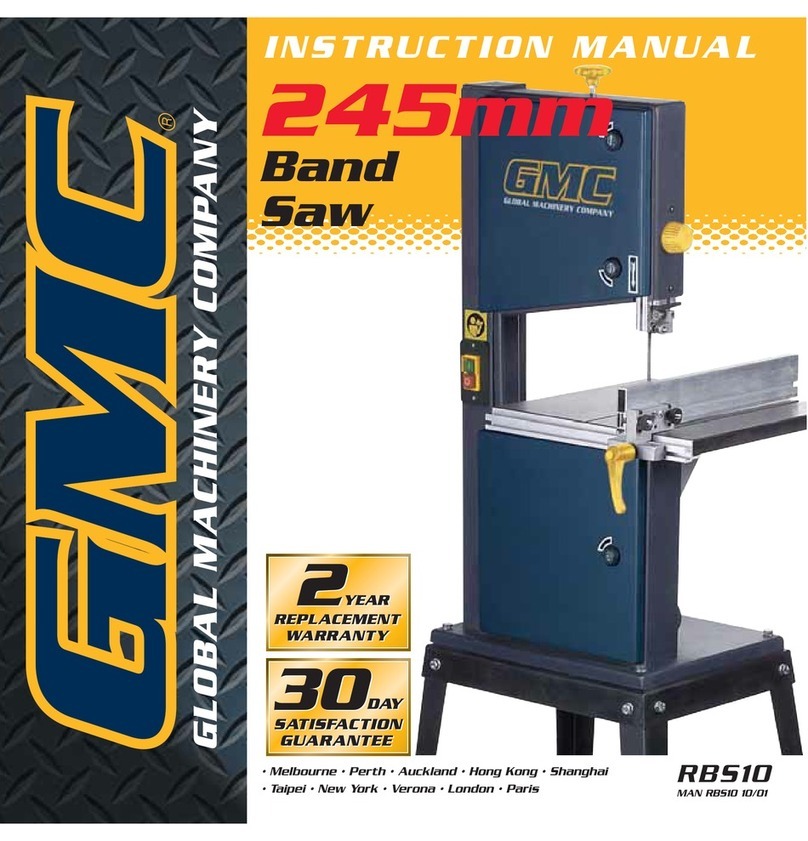
GMC
GMC RBS10 instruction manual

MK Diamond Products
MK Diamond Products MK-2000 PRO Series Owner's manual operating instruction & parts list




